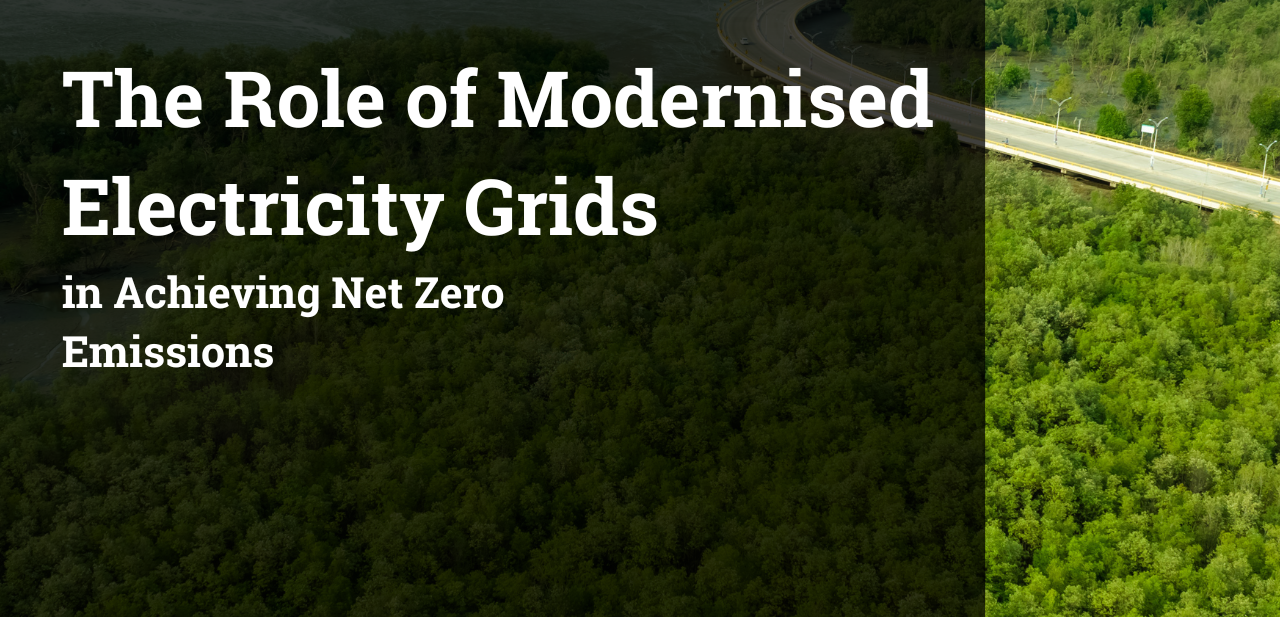
The Role of Modernised Electricity Grids in Achieving Net Zero Emissions
To combat climate change and fuel scarcity, the transition to clean energy has become an urgent and non-negotiable priority. As renewable energy sources become commonplace, the need for modernised electrical grids becomes increasingly urgent. Achieving this will only be possible if we embrace collaboration, partnership and flexibility.
Modernising Grids: A Prerequisite for a Sustainable Future
Electricity grids have steadfastly delivered power around the globe for over a century. However, as the demand for clean energy grows and the role of electricity expands, modern and expanded grids become essential to achieving national energy goals. Especially as the International Energy Agency (IEA) projects that electricity usage needs to increase 20% faster in the upcoming decade to set us on the path to net zero emissions by 2050 and limit global temperature rise to 1.5°C.
To understand the significance of grid modernisation, we can draw parallels to the evolution of the computing and telecom industries. In the computing world, we witnessed the transition from centralised mainframes to powerful distributed systems. Similarly, the telecoms industry evolved from central exchanges with physical copper lines to, first, fibre cables and now, wireless networks. These transformations allowed for greater efficiency and accessibility, significantly benefiting end-users.
Today, we find ourselves on the cusp of a similar evolution in the electricity networks. The concept of the grid edge, where more power generation is embedded closer to end-users, offers several advantages. By reducing the reliance on a centralised main grid structure, the performance requirements can be shifted to the grid edge, resulting in cost savings and improved infrastructure efficiency. Just as powerful handheld devices enable access to computers whenever we need it, power at the grid edge can be tailored to individual needs, ensuring the right amount of electricity at the right place and the right time.
Cost Reduction and Carbon Efficiency
One of the primary benefits of grid modernisation lies in its cost-saving potential. By empowering industrial and commercial sectors to have greater control over their energy supply, grid modernisation alleviates the need for extensive grid infrastructure upgrades. With the IEA estimating that by 2040, over 80 million kilometres of grids will need to be added or refurbished to service growing demand, embedding flexibility at the grid edge has never been more crucial.
This cost reduction not only benefits end-users but also allows grid operators to focus their efforts on providing personalised solutions to meet the specific requirements of individual customers and communities. Enabling power generation closer to end-users also contributes to achieving net zero emissions by optimising carbon content and reducing transmission losses.
The Challenge for Grids
It is evident that to meet our ambitious energy goals, there is a pressing need for larger and smarter grids. Integrating electric vehicles, heating systems, and hydrogen production adds to the complexity of the grid’s role. It needs to be able to accommodate the evolving energy landscape.
It’s unsurprising, then, that the IEA has said that flexibility of the system will become twice as important between 2022 and 2030, emphasising the need for technologies that enhance grid functionality, flexibility and storage. This must include flexibility at the grid edge so that consumers can access energy where and when they need it.
However, despite the surging investment in renewable energy projects, grid development remains stagnant, with an annual investment of only around USD 300 billion. Infrastructure development is also notoriously slow, taking, on average, 5-15 years (versus 1-5 for a renewable energy project). This imbalance could impede progress, increase global carbon dioxide emissions, and jeopardise climate goals.
The Risks of Delayed Grid Development
The consequences of delaying grid development are far-reaching. Numerous renewable power projects are currently awaiting grid connections, stalling their progression. The delay not only makes countries more reliant on fossil fuels like gas and coal but also increases the likelihood of power outages, resulting in substantial financial losses.
We’ve seen these challenges firsthand on a recent feasibility project funded by BEIS, working on behalf of a national supermarket. The project findings highlighted that the biggest barrier to the supermarket’s 2035 Net Zero goal is the lack of timely access to clean and reliable electricity. The site we were working to electrify has a capacity limit of 1.5 MW. However, it required 10.5 MW to electrify the site (which includes transport, chillers and cold store). To be able to access the capacity it requires would mean installing a new grid cable from the site to the nearest National Grid substation, over 10 miles away.
Overcoming Challenges for a Sustainable Grid
To accelerate the transition to renewable energy, the IEA reports that global grid investment must double by 2030, reaching over $600 billion annually. While this increase in investment is paramount (especially in emerging and developing economies where grid investments have declined despite rising electricity demands), some things can be done to ease the pressure on national grids.
While the grid will likely always act as the backbone of the system, new technologies allow consumers to develop highly localised energy systems that include on-site energy generation and storage. But this is only possible if we start to see more collaboration between governments, regulatory bodies, and industry stakeholders. Embracing modernisation and flexibility at the grid edge will make it possible to meet Net Zero goals while reducing costs for end users.
